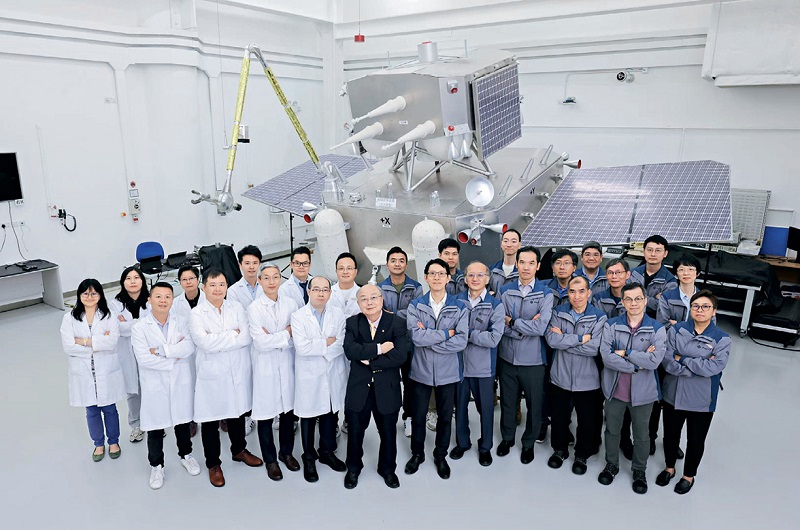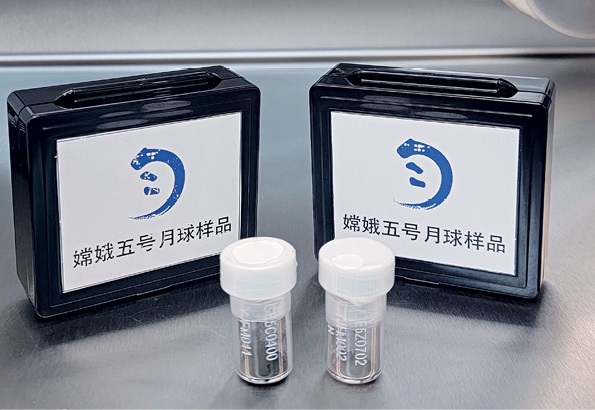A Hong Kong-based research center contributes to deep space missions both nationally and internationally.

Group photo of Prof. Yung Kai-leung (center) and his research team with the experts at PolyU’s Industrial Center.
The Research Center for Deep Space Explorations (RCDSE) at the Hong Kong Polytechnic University (PolyU) showcases several unique things that seem straight out of a sci-fi film. There is an extraordinary Mars surveillance camera and complex equipment for collecting samples from another planet and packing them for safe transportation to earth. “We also have facilities to store and analyze extraterrestrial samples in a non-destructive way,” said Prof. Yung Kai-leung, director of the RCDSE. “They maintain high-purity nitrogen gas for long-term storage and in-depth analysis of lunar soil.”
PolyU has the advantage of its long experience in interdisciplinary research, which includes developing space engineering payloads for deep space missions. Buoyed by its successful participation in aerospace missions, PolyU established the RCDSE in 2021 to do further research in developing payloads as well as new interdisciplinary space resource research.
The director of the RCDSE, Prof. Yung Kai-leung, who is a Sir Sze-yuen Chung professor in precision engineering, chair professor of precision engineering and associate head of the Department of Industrial and Systems Engineering, is known for his work in precision aerospace engineering research. He has extensive experience in deep space explorations. RCDSE researchers have participated in some major national aerospace projects, including technical R&D for China’s lunar and Mars missions.
In the space industry, innovative key technologies that ensure reliability, safety, and performance are its new quality productive forces.
At present, the RCDSE has four major research focuses: planetary surface construction and geotechnical mechanics, planetary resources and microbes, planetary remote sensing and mapping, and space environment and payload research. The lunar and extraterrestrial soil storage and analysis facilities of the center are assisting research on the soil samples brought from the moon by the Chang’e-5 and -6 missions, as well as cross institutional collaborative research on samples from other extraterrestrial sources.
Lifting the Veil on the Moon
On June 25, the return capsule of the Chang’e-6 spacecraft landed precisely in the designated area of Northern China’s Inner Mongolia, carrying samples from the far side of the moon. Prior to this, all the lunar samples collected were from the near side of the moon.
The system to collect samples and pack them securely for this mission was developed by PolyU and the China Academy of Space Technology (CAST). Yung’s team had developed the system as early as in 2020, which was used in the Chang’e-5 mission. The complex system is composed of over 400 pieces, of which Yung’s team designed the near-field cameras, samplers, and sealing and packaging system.
The regolith – fine-grained soil samples – brought back by the Chang’e-6 is different from the samples from the near side of the moon due to factors such as the more frequent meteorite impacts on the far side and more intense solar wind effects. The regolith samples are currently stored in the lunar regolith storage and analysis system on the PolyU campus. It is a unique state-of-the-art integrated multifunctional system for in-situ analysis, where researchers can study the samples without having to take them out of protective storage.
“Analysis of these samples will throw light on the unique geological structures and material composition on the far side of the moon, provide a more comprehensive understanding of the geological evolution history of the moon, and lead to breakthroughs in scientific research,” Yung said. Scientists can now better understand the internal structure and material composition of the moon.

PolyU successfully acquires lunar soil samples collected by China’s Chang’e-5 mission, including a 400 mg surface sample (left) and a 42.6 mg deep drill sample (right).
Collaboration across Borders
The PolyU has participated in many deep space missions both nationally and internationally since the 1990s. It developed a number of critical instruments for international missions such as a Mars rock corer for the European Space Agency (ESA)’s Mars Express mission in 2003, a soil preparation system for the historic Sino-Russian Phobos-Grunt mission in 2011 to study Mars’s moon Phobos, and the Jovian neutral analyzer for the ESA’s Jupiter Icy Moons Explorer mission in 2023, which sought to explore Jupiter and three of its largest icy moons. The analyzer is a sensor which provides images despite the harsh radiation environment on Jupiter.
“Nationally, we have been involved in the deep space explorations since 2010,” Yung said. His team developed advanced precision robotic systems for lunar exploration missions such as the camera pointing system for Chang’e-3 and - 4 in 2013 and 2019, the surface sampling and packing system for Chang’e-5 and -6 in 2020 and 2024, and the Mars landing surveillance camera for the Tianwen-1 mission in 2021, China’s first Mars soft landing and exploration.
The Mars surveillance camera captured high-quality ultra-wide-angle images of the Mars rover and its surroundings so that the rover could be deployed with precision.
“The Mars camera is the eye of a probe,” Yung said. The camera, while it has a wide field of view with low distortion optics, can withstand extreme temperature variation, high radiation, mechanical impact, and vibration. Despite weighing only 390 grams, it is able to withstand an impact shock of 6,200G (G = earth’s gravitational force).
Talking about the collaboration with ESA, Yung said, “We have gained fruitful experience and new insights from international space research collaboration that helped to raise our innovations in national space endeavors. We introduced a lot of innovation in the design of lightweight multifunction devices and gained a lot of experience in making spaceworthy instruments.”
The Chang’e-6 mission carried international payloads, including the ESA’s lunar surface negative ion analyzer, France’s radon detector, Italy’s laser angle reflector, and Pakistan’s small satellite cubesat. The practical and efficient international cooperation received widespread attention and acclaim.
After the Chang’e-6 probe executed a near-moon braking procedure and entered an orbit around the satellite, the cubesat separated from it, and captured and successfully transmitted lunar images. The China National Space Administration (CNSA) handed over the cubesat data to Pakistan. The radon detector completed its mission and is now a permanent resident on the far side of the moon.
To encourage and facilitate international cooperation, the CNSA has formulated measures for the management of lunar samples and rules for international cooperation. The application process for research of the lunar samples has been revealed in details so that researchers from other countries can share the results of China’s exploration.
“In the future, the country will have more aerospace exploration missions, for example, Mars sampling missions. But we still need key technological breakthroughs and will encounter major challenges. Our team is fully prepared, and the laboratory has been expanded, adding a lot of new experimental space, Yung said, “The long-term goal is to develop more new technologies to help explore and utilize space resources. Currently, we need in-depth research on the collected lunar soil to find out how to extract and utilize the resources lunar soil contains.”